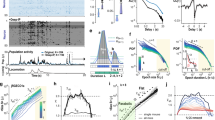Abstract
I investigate whether cortical γ-oscillations are relevant to reading out synchronous neuronal firings that are distributed over the brain. A cortical neural network model is proposed and simulated. The model consists of two sensory networks (SI and SII) and one coincidence-sensitive network (CS). γ-oscillatory inputs and external stimuli are applied to interneurons and projection neurons of the sensory networks, respectively. The SI and SII networks project to the CS network in a divergent/convergent manner. Here I show that beating in membrane potential of CS neurons mediates the detection of synchronous neuronal firings between the SI and SII networks. A slight increase (a few Hz) in difference between frequencies of the γ-oscillations in the SI and SII networks generates the beating in the CS network. The synchronous neuronal firings are detected at each peak of the beating, regardless of difference in signal transmission time between SI-to-CS and SII-to-CS pathways.
Similar content being viewed by others
References
Frien, A., Eckhorn, R., Bauer, R., Woelbern T. and Kehr, H.: Stimulus-specific fast oscillations at zero phase between visual areas V1 and V2 of awake monkey, Neuroreport, 21 (1994), 2273–2277.
König, O., Engel, A.K. and Singer, W.: Relation between oscillatory activity and longrange synchronization in cat visual cortex, Proc. Natl. Acad. Sci. USA, 92 (1995), 290–294.
Roelfsema, P.R., Engel, A.K., König, P. and Singer, W.: Visuomotor integration is associated with zero time-lag synchronization among cortical areas, Nature, 385 (1997), 157–161.
Engel, A.K., Roelfsema, P.R., Fries, P., Brecht, M. and Singer, W.: Role of the temporal domain for response selection and perceptual binding, Cereb Cortex, 7 (1997), 571–582.
von der Malsburg, C.: Binding in models of perception and brain function, Curr. Opin. Neurobiol., 5 (1995), 520–526.
Ritz, R. and Sejnowski, T.J.: Synchronous oscillatory activity in sensory systems: new vistas on mechanisms, Curr. Opin. Neurobiol., 7 (1997), 536–546.
Yost, W.: Fundamentals of hearing, Academic Press: San Diego, CA, 1994.
Hoshino, O., Kashimori, Y. and Kambara, T.: An olfactory recognition model based on spatio-temporal encoding of odor quality in olfactory bulb, Biol. Cybern., 79 (1998), 109–120.
Hoshino, O., Inoue, S., Kashimori, Y. and Kambara, T.: A hierarchical dynamical map as a basic frame for cortical mapping and its application to priming, Neural computation, 13 (2001), 1781–1810.
Softky, W.: Sub-millisecond coincidence detection in active dendritic trees, Neurosci., 58 (1994), 13–41.
Softky, W.: Simple codes versus efficient codes, Curr. Opin. Neurosci., 5 (1995), 239–247.
Koch, C., Rappand, M. and Segev, I.: A brief history of time (constants), Cerebral Cortex, 6 (1996), 93–101.
Whittington, M.A., Traub, R.D. and Jefferys, J.G.: Synchronized oscillations in interneuron networks driven by metabotropic glutamate receptor activation, Nature, 373 (1995), 612–615.
Traub, R.D., Jefferys, J.G. and Whittington, M.A.: Fast Oscillations in Cortical Circuits, MIT Press: Cambridge, MA, 1999.
György, B. and Chroback, J.J.: Temporal structure in spatially organized neuronal ensembles: a role for interneural networks, Curr. Opin. Neurobiol. 5 (1995), 504–510.
Traub, R.D., Whittington, M.A., Colling, S.B., Buzsaki, G. and Jefferys, J.G.: Analysis of gamma rhythms in the rat hippocampus in vitro and in vivo, J. Physiol., 493 (1996), 471–484.
Webster, M.J. and Ungerleider, L.G.: Neuroanatomy of visual attention, In: R. Parasuraman (ed.) The Attentive Brain, pp. 20–34, MIT Press: Cambridge, MA, 1998.
Kastner, S. and Ungerleider, L.G.: Mechanisms of visual attention in the human cortex, Annu. Rev. Neurosci., 23 (2000), 315–341.
Lamme, C.A.F. and Roelfsema, P.R.: The distinct modes of vision offered by feedforward and recurrent processing, TINS, 23 (2000), 571–579.
Tanaka, K.: Mechanisms of visual object recognition: monkey and human studies, Curr. Opin. Neurobiol., 7 (1997), 523–529.
Saleem, K.S. and Tanaka, K.: Divergent projections from the anterior inferotemporal area TA to the perirhinal and entorhinal cortices in the macaque monkey, J. Neurosci., 16 (1996), 4757–4775.
Suzuki, W.A. and Amaral, D.G.: Perirhinal and parahippocampal cortices of the macaque monkey: cortical afferents, J. Comp. Neurol., 350 (1994), 497–533.
Damasio, A.R.: The brain binds entities and events by multiregional activation from convergence zones, Neural Computation, 1 (1989), 123–132.
Damasio, A.R. and Damasio, H.: Cortical systems for retrieval of concrete knowledge: The convergence zone framework, In: C. Koch (ed.) Large-scale neuronal theories of the brain, pp. 61–74, MIT Press: Cambridge, MA, 1994.
Author information
Authors and Affiliations
Rights and permissions
About this article
Cite this article
Hoshino, O. Beating in Membrane Potential Mediated by Cortical γ-Oscillations for Reading Out Synchronous Neuronal Activities Over Distant Cortical Areas. Neural Processing Letters 16, 165–175 (2002). https://doi.org/10.1023/A:1019982520733
Issue Date:
DOI: https://doi.org/10.1023/A:1019982520733




